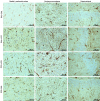Propentofylline Prevents Sickness Behavior and Depressive-Like Behavior Induced by Lipopolysaccharide in Rats via Neuroinflammatory Pathway
- PMID: 28056040
- PMCID: PMC5215944
- DOI: 10.1371/journal.pone.0169446
Propentofylline Prevents Sickness Behavior and Depressive-Like Behavior Induced by Lipopolysaccharide in Rats via Neuroinflammatory Pathway
Abstract
Recent studies have demonstrated the intimate relationship between depression and immune disturbances. Aware of the efficacy limits of existing antidepressant drugs and the potential anti-inflammatory properties of propentofylline, we sought to evaluate the use of propentofylline as a depression treatment. We used a rat model of depression induced by repetitive lipopolysaccharide (LPS) administrations. We have studied sickness behavior, by assessing daily body weight, open field behavior, and TNF-α plasmatic levels. Anxiety-like behavior (light-dark test), depressive-like behavior (forced swim test), plasmatic levels of the brain-derived neurotrophic factor (BDNF, depression biomarker), and central glial fibrillary acidic protein (GFAP) expression (an astrocyte biomarker) were also evaluated. LPS induced body weight loss, open field behavior impairments (decreased locomotion and rearing, and increased immobility), and increased TNF-α levels in rats, compared with control group. Thus, LPS induced sickness behavior. LPS also increased the immobility and reduced climbing in the forced swim test, when compared with the control group, i.e., LPS induced depressive-like behavior in rats. Propentofylline prevented sickness behavior after four days of consecutive treatment, as well as prevented the depressive-like behavior after five days of consecutive treatments. Propentofylline also prevented the increase in GFAP expression induced by LPS. Neither LPS nor propentofylline has influenced the anxiety and BDNF levels of rats. In conclusion, repetitive LPS administrations induced sickness behavior and depressive-like behavior in rats. Propentofylline prevented both sickness behavior and depressive-like behavior via neuroinflammatory pathway. The present findings may contribute to a better understanding and treatment of depression and associated diseases.
Conflict of interest statement
The authors have declared that no competing interests exist.
Figures







References
-
- Thompson C, Ostler K, Peveler RC, Baker N, Kinmonth AL. Dimensional perspective on the recognition of depressive symptoms in primary care: The Hampshire Depression Project 3. Br J Psychiatry. 2001;179:317–23. Epub 2001/10/03. - PubMed
-
- Carroll LJ, Cassidy JD, Cote P. Factors associated with the onset of an episode of depressive symptoms in the general population. J Clin Epidemiol. 2003;56(7):651–8. Epub 2003/08/19. S0895435603001185 [pii]. - PubMed
-
- Clark DC. Suicide risk assessment and prediction in the 1990s. Crisis. 1990;11(2):104–12. Epub 1990/11/01. - PubMed
-
- Lonnqvist JK, Henriksson MM, Isometsa ET, Marttunen MJ, Heikkinen ME, Aro HM, et al. Mental disorders and suicide prevention. Psychiatry Clin Neurosci. 1995;49 Suppl 1:S111–6. Epub 1995/05/01. - PubMed
MeSH terms
Substances
LinkOut - more resources
Full Text Sources
Other Literature Sources
Medical
Miscellaneous

